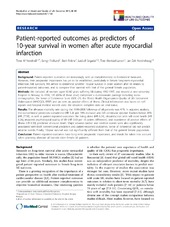| dc.description.abstract | Background Patient-reported outcomes are increasingly seen as complementary to biomedical measures. However, their prognostic importance has yet to be established, particularly in female long-term myocardial infarction (MI) survivors. We aimed to determine whether 10-year survival in older women after MI relates to patient-reported outcomes, and to compare their survival with that of the general female population. Methods We included all women aged 60-80 years suffering MI during 1992-1997, and treated at one university hospital in Norway. In 1998, 145 (60% of those alive) completed a questionnaire package including socio-demographics, the Sense of Coherence Scale (SOC-29), the World Health Organization Quality of Life Instrument Abbreviated (WHOQOL-BREF) and an item on positive effects of illness. Clinical information was based on self-reports and hospital medical records data. We obtained complete data on vital status. Results The all-cause mortality rate during the 1998-2008 follow-up of all patients was 41%. In adjusted analysis, the conventional predictors s-creatinine (HR 1.26 per 10% increase) and left ventricular ejection fraction below 30% (HR 27.38), as well as patient-reported outcomes like living alone (HR 6.24), dissatisfaction with self-rated health (HR 6.26), impaired psychological quality of life (HR 0.60 per 10 points difference), and experience of positive effects of illness (HR 6.30), predicted all-cause death. Major adverse cardiac and cerebral events were also significantly associated with both conventional predictors and patient-reported outcomes. Sense of coherence did not predict adverse events. Finally, 10-year survival was not significantly different from that of the general female population. Conclusion Patient-reported outcomes have long-term prognostic importance, and should be taken into account when planning aftercare of low-risk older female MI patients. | en_US |

